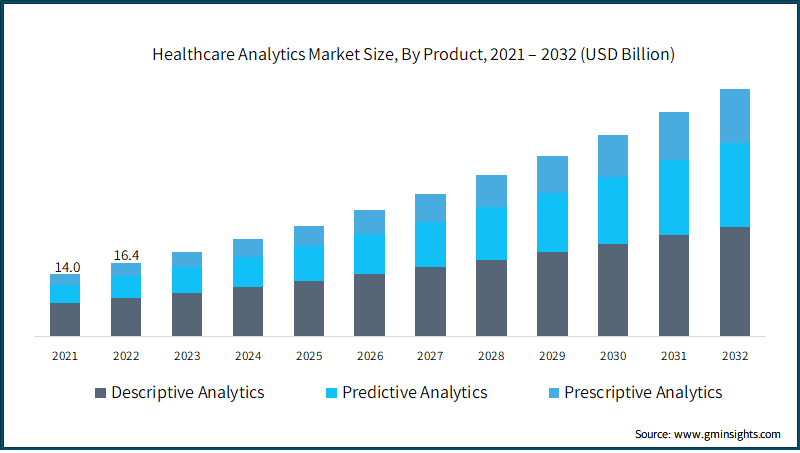Home > Healthcare > Healthcare IT > Payer/Provider Solutions > Healthcare Analytics Market
Healthcare Analytics Market Analysis
- Report ID: GMI1400
- Published Date: Nov 2023
- Report Format: PDF
Healthcare Analytics Market Analysis
Based on product, the market is segmented into descriptive analytics, predictive analytics and prescriptive analytics. In 2022, the market witnessed descriptive analytics as the dominant segment, representing the highest share with a market value of USD 8.6 billion
- Descriptive analytics is the simplest form of healthcare analytics tools and is largely employed in analysing data, describing relationships and trends using current and historical data. Using such datapoints, descriptive healthcare analytics provides decision makers a holistic view to base their business strategies on. Thus, descriptive analytics helps to interpret results of analysis as well as validate analytical findings, among others.
- Further, increasing implementation of descriptive healthcare analytics in hospitals and other healthcare institutions is also contributing to the segment share.

Based on applications, the healthcare analytics market is classified into operations management, financial management, population health management and clinical management. In 2022, the financial management segment held the largest share of 33.5% in the global market.
- Increasing market demand for efficient healthcare facilities is boosting the segment landscape. Healthcare institutions are noted to increasingly focus on minimizing the overall cost of treatments while delivering optimum quality of care for patients.
- Facilities are noted to implement healthcare analytics for financial management in order to maintain an optimum inventory to manage overspending or underspending on capital instruments and consumables.
- Further, with increasing number of insurance claims, the demand for optimum financial management is also observed to increase in order to detect fraudulent claims. Hence, the aforementioned factors largely contribute to the segment growth.
Based on end-use, the healthcare analytics market is classified into hospitals clinics and other end-users. The hospital segment held the largest share of the total revenue at 71.6%. in 2022.
- Factors such as analyzing clinical data management to improve medical research, obtaining operational insights, utilization of patients’ data to improve health outcomes, studying regional population health, among others, have resulted in growing adoption rates for healthcare analytics solutions and other tools across healthcare facilities, predominantly in hospitals.
- Furthermore, several healthcare organizations are moving forward with incorporation of various healthcare analytics tools and software to minimize human error and reduce subsequent costs, thereby fostering the market development.

The North American healthcare analytics market is anticipated to exhibit substantial growth, maintaining its dominance with a market share exceeding 63% during the entire forecast period.
- North America's leading market share in healthcare analytics can be attributed to its cutting-edge healthcare facilities, widespread adoption of advanced platforms, and robust technological infrastructure.
- Increasing prevalence of chronic diseases along with rising geriatric population creates a need for hospitals and other organizations to adopt healthcare analytics solutions. Therefore, rising adoption of healthcare analytics helps in lowering operational costs, promotes innovations and enhances quality of care delivered.
- Furthermore, technological advancements in data analytics along with a high density of prominent players operating in the regional market are few other factors that favour the North America healthcare analytics industry expansion.

